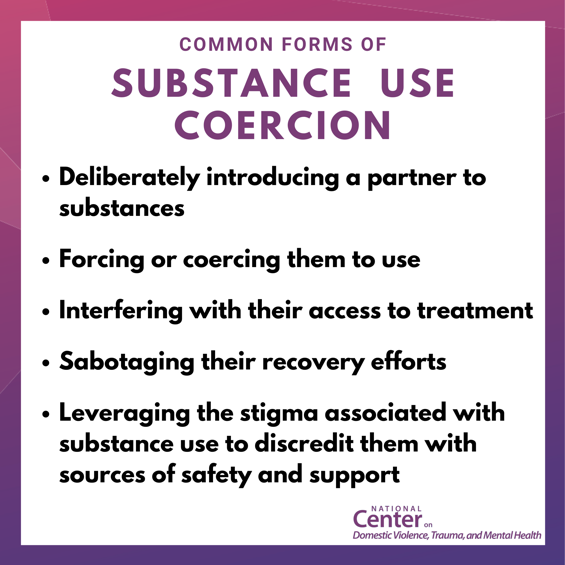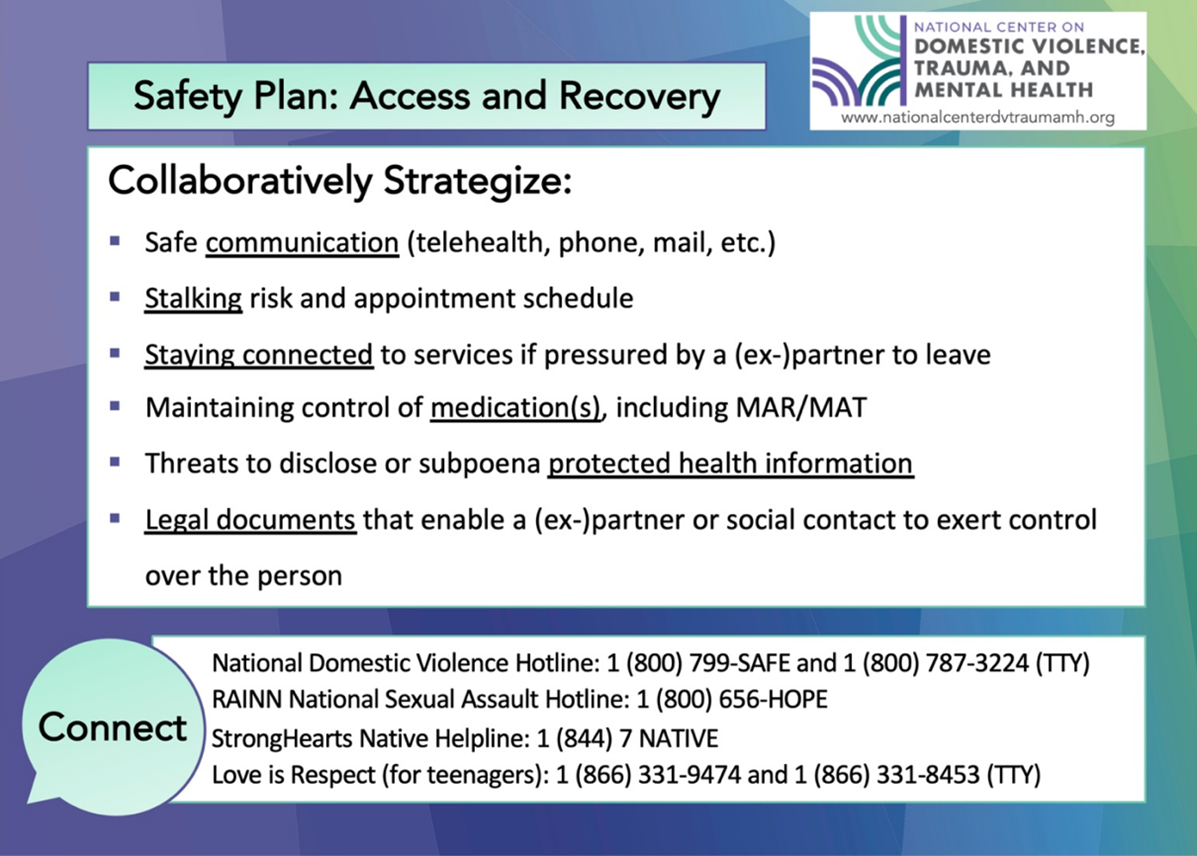Beyond Trauma-Informed: A Simple Tool to Support Survivors of Intimate Partner Violence
Gabriela Zapata-Alma, LCSW, CADC, and Carole Warshaw, MD
National Center on Domestic Violence, Trauma, and Mental Health
With decades of research documenting the relationship between substance use disorders and intimate partner violence (IPV), it’s of little surprise that people in need of substance use disorder treatment and recovery services also commonly experience concerns related to IPV (Phillips et al., 2020). While IPV impacts people of all genders, women and LGBTQ+ persons experience higher rates of IPV as well as other forms of interpersonal violence, including sexual violence, human trafficking, and hate-motivated violence (Chen et al., 2023; Flores et al., 2022; UNODC, 2022; James et al., 2016; Walters et al., 2013).
substance use disorders and intimate partner violence (IPV), it’s of little surprise that people in need of substance use disorder treatment and recovery services also commonly experience concerns related to IPV (Phillips et al., 2020). While IPV impacts people of all genders, women and LGBTQ+ persons experience higher rates of IPV as well as other forms of interpersonal violence, including sexual violence, human trafficking, and hate-motivated violence (Chen et al., 2023; Flores et al., 2022; UNODC, 2022; James et al., 2016; Walters et al., 2013).
 Being abused by an intimate partner can have significant impacts on a person’s health, including their mental health and use of substances. In addition to these trauma-related effects, survivors many times face a form of abuse known as substance use coercion. This form of abuse specifically uses substances to harm, threaten, coerce, and isolate survivors, often keeping survivors from the very resources that could help. At the same time, unsafe partners will often leverage substance use stigma to strengthen their control over survivors and turn systems (e.g. courts, child protective services, housing, employment, law enforcement) against survivors. All of this requires programs to move beyond trauma-informed care to incorporate a comprehensive IPV-responsive approach to services (see authors’ 2020 ATTC Messenger article).
Being abused by an intimate partner can have significant impacts on a person’s health, including their mental health and use of substances. In addition to these trauma-related effects, survivors many times face a form of abuse known as substance use coercion. This form of abuse specifically uses substances to harm, threaten, coerce, and isolate survivors, often keeping survivors from the very resources that could help. At the same time, unsafe partners will often leverage substance use stigma to strengthen their control over survivors and turn systems (e.g. courts, child protective services, housing, employment, law enforcement) against survivors. All of this requires programs to move beyond trauma-informed care to incorporate a comprehensive IPV-responsive approach to services (see authors’ 2020 ATTC Messenger article).
A Simple Tool to Support Survivors of Intimate Partner Violence
The Substance Use Coercion Palm Card is a quick-reference tool that supports counselors, recovery specialists, and healthcare providers to be able to open conversations about substance use coercion and support survivors’ emotional and physical safety, including connecting survivors to anti-violence advocacy resources. Available in English, Spanish, and coming soon in French, this tool offers conversational prompts as well as safety planning ideas and hotline resources. Here are the basic steps summarized in the tool:

- Build Safety – First, create safe opportunities for survivors to be able to talk about their experiences, including by strengthening existing privacy, confidentiality, and telehealth practices. Keeping in mind that survivors often experience increased danger as well as judgment and victim-blaming when disclosing IPV, it’s essential that practitioners create a space that is both physically and emotionally safe for survivors to discuss their experiences.
- Open Conversation – If it is safe to talk about substance use coercion, offer some information about substance use coercion while avoiding the use of labels (such as “abusive” or “domestic violence”). Let the person know that you are here to support them, while at the same time supporting them in deciding when and how they’d like to discuss this topic (if at all).
- Recognize Abuse – IPV often goes unnoticed because of how people who abuse their partners try to normalize their behavior - or even worse, to make the abuse seem like it’s a survivor’s fault. Be ready to recognize IPV by learning about the many power and control tactics often used in substance use coercion and IPV more generally.
- Validate and Affirm – When a survivor shares experiences of IPV, respond with validation and affirmation. Avoid jumping into problem solving. Follow the person’s lead and focus on what they would find helpful at this time.
- Offer Support – Ask permission before moving into a conversation about safety planning or connecting with resources.

- Safety Planning – Partner with the person to support them in strategizing around their overall safety, their safety related to substance use, and their ongoing connection to services and resources. Engage with empathy and creativity, remembering that they are the expert on their lives and only they can know what is most safe and accessible with their situation.
- Connect with IPV Resources – Domestic Violence Advocates are experts in supporting survivors and their families as they navigate ongoing safety needs, resource gaps, complex systems, and work to establish safety and stability. Get to know local resources to facilitate seamless access for survivors experiencing substance use coercion.
As a counselor, recovery specialist, or healthcare provider, there’s much you can do to help. For the people who are experiencing IPV and substance use coercion, having a safe place to talk about these experiences as well as access to information, resources, and support, can make a life-saving difference. Visit The National Center on Domestic Violence, Trauma, and Mental Health’s website to access information, tools, and webinars at no cost, as well as to request free expert consultation.
References
Chen, J., Khatiwada, S., Chen, M. S., Smith, S. G., Leemis, R. W., Friar, N., Basile, K. C., and Kresnow, M. (2023). The National Intimate Partner and Sexual Violence Survey (NISVS) 2016/2017: Report on Victimization by Sexual Identity. National Center for Injury Prevention and Control, Centers for Disease Control and Prevention.
Flores, A. R., Stotzer, R. L., Meyer, I. H., & Langton, L. L. (2022). Hate crimes against LGBT people: National Crime Victimization Survey, 2017-2019. PloS one, 17(12), e0279363. https://doi.org/10.1371/journal.pone.0279363
James, S. E., Herman, J. L., Rankin, S., Keisling, M., Mottet, L., & Anafi, M. (2016). The Report of the 2015 U.S. Transgender Survey. Washington, DC: National Center for Transgender Equality.
Phillips, H., Warshaw, C., & Kaewken, O. (2020). Literature Review: Intimate Partner Violence, Substance Use Coercion, and the Need for Integrated Service Models. National Center on Domestic Violence, Trauma, and Mental Health.
UNODC. (2022). Global Report on Trafficking in Persons. United Nations publication, Sales no.: E.23.IV.1.
Walters, M.L., Chen J., & Breiding, M.J. (2013). The National Intimate Partner and Sexual Violence Survey (NISVS): 2010 Findings on Victimization by Sexual Orientation. National Center for Injury Prevention and Control, Centers for Disease Control and Prevention
Warshaw, C., and Zapata-Alma, G. (2020). In Honor of Domestic Violence Awareness Month: Responding to Substance Use Coercion in Treatment and Recovery Services. ATTC Messenger.
Warshaw, C. and Tinnon, E., (2018). Coercion Related to Mental Health and Substance Use in the Context of Intimate Partner Violence: A Toolkit for Screening, Assessment, and Brief Counseling in Primary Care and Behavioral Health Settings. National Center on Domestic Violence, Trauma, and Mental Health.
 substance use disorders and intimate partner violence (IPV), it’s of little surprise that people in need of substance use disorder treatment and recovery services also commonly experience concerns related to IPV (Phillips et al., 2020). While IPV impacts people of all genders, women and LGBTQ+ persons experience higher rates of IPV as well as other forms of interpersonal violence, including sexual violence, human trafficking, and hate-motivated violence (Chen et al., 2023; Flores et al., 2022; UNODC, 2022; James et al., 2016; Walters et al., 2013).
substance use disorders and intimate partner violence (IPV), it’s of little surprise that people in need of substance use disorder treatment and recovery services also commonly experience concerns related to IPV (Phillips et al., 2020). While IPV impacts people of all genders, women and LGBTQ+ persons experience higher rates of IPV as well as other forms of interpersonal violence, including sexual violence, human trafficking, and hate-motivated violence (Chen et al., 2023; Flores et al., 2022; UNODC, 2022; James et al., 2016; Walters et al., 2013). Being abused by an intimate partner can have significant impacts on a person’s health, including their mental health and use of substances. In addition to these trauma-related effects, survivors many times face a form of abuse known as substance use coercion. This form of abuse specifically uses substances to harm, threaten, coerce, and isolate survivors, often keeping survivors from the very resources that could help. At the same time, unsafe partners will often leverage substance use stigma to strengthen their control over survivors and turn systems (e.g. courts, child protective services, housing, employment, law enforcement) against survivors. All of this requires programs to move beyond trauma-informed care to incorporate a comprehensive IPV-responsive approach to services (see authors’ 2020 ATTC Messenger article).
Being abused by an intimate partner can have significant impacts on a person’s health, including their mental health and use of substances. In addition to these trauma-related effects, survivors many times face a form of abuse known as substance use coercion. This form of abuse specifically uses substances to harm, threaten, coerce, and isolate survivors, often keeping survivors from the very resources that could help. At the same time, unsafe partners will often leverage substance use stigma to strengthen their control over survivors and turn systems (e.g. courts, child protective services, housing, employment, law enforcement) against survivors. All of this requires programs to move beyond trauma-informed care to incorporate a comprehensive IPV-responsive approach to services (see authors’ 2020 ATTC Messenger article).